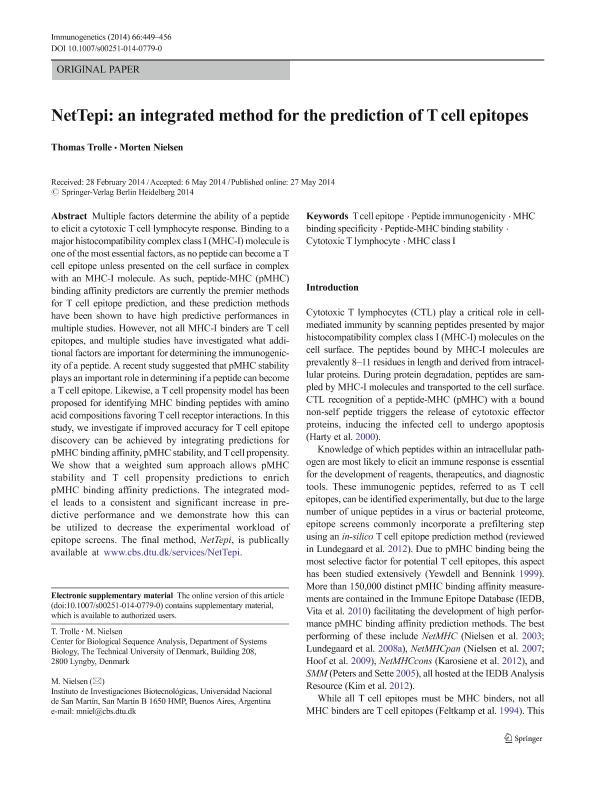Mostrar el registro sencillo del ítem
dc.contributor.author
Trolle, Thomas

dc.contributor.author
Nielsen, Morten

dc.date.available
2017-06-09T17:44:30Z
dc.date.issued
2014-08
dc.identifier.citation
Trolle, Thomas; Nielsen, Morten; NetTepi: an integrated method for the prediction of T-cell epitopes; Springer Verlag Berlín; Immunogenetics; 66; 7; 8-2014; 449-456
dc.identifier.issn
0093-7711
dc.identifier.uri
http://hdl.handle.net/11336/17886
dc.description.abstract
Multiple factors determine the ability of a peptide to elicit a cytotoxic T cell lymphocyte response. Binding to a major histocompatibility complex class I (MHC-I) molecule is one of the most essential factors, as no peptide can become a T cell epitope unless presented on the cell surface in complex with an MHC-I molecule. As such, peptide-MHC (pMHC) binding affinity predictors are currently the premier methods for T cell epitope prediction, and these prediction methods have been shown to have high predictive performances in multiple studies. However, not all MHC-I binders are T cell epitopes, and multiple studies have investigated what additional factors are important for determining the immunogenicity of a peptide. A recent study suggested that pMHC stability plays an important role in determining if a peptide can become a T cell epitope. Likewise, a T cell propensity model has been proposed for identifying MHC binding peptides with amino acid compositions favoring T cell receptor interactions. In this study, we investigate if improved accuracy for T cell epitope discovery can be achieved by integrating predictions for pMHC binding affinity, pMHC stability, and T cell propensity. We show that a weighted sum approach allows pMHC stability and T cell propensity predictions to enrich pMHC binding affinity predictions. The integrated model leads to a consistent and significant increase in predictive performance and we demonstrate how this can be utilized to decrease the experimental workload of epitope screens. The final method, NetTepi, is publically available at www.cbs.dtu.dk/services/NetTepi
dc.format
application/pdf
dc.language.iso
eng
dc.publisher
Springer Verlag Berlín

dc.rights
info:eu-repo/semantics/openAccess
dc.rights.uri
https://creativecommons.org/licenses/by-nc-sa/2.5/ar/
dc.subject
T Cell Epitope
dc.subject
Peptide Immunogenicity
dc.subject
Mhc Binding Specificity
dc.subject
Peptide-Mhc Binding Stability
dc.subject
Cytotoxic T Lymphocyte
dc.subject
Mhc Class I
dc.subject.classification
Otras Ciencias de la Salud

dc.subject.classification
Ciencias de la Salud

dc.subject.classification
CIENCIAS MÉDICAS Y DE LA SALUD

dc.title
NetTepi: an integrated method for the prediction of T-cell epitopes
dc.type
info:eu-repo/semantics/article
dc.type
info:ar-repo/semantics/artículo
dc.type
info:eu-repo/semantics/publishedVersion
dc.date.updated
2017-06-09T15:01:02Z
dc.identifier.eissn
1432-1211
dc.journal.volume
66
dc.journal.number
7
dc.journal.pagination
449-456
dc.journal.pais
Alemania

dc.journal.ciudad
Berlín
dc.description.fil
Fil: Trolle, Thomas. Technical University Of Denmark; Dinamarca
dc.description.fil
Fil: Nielsen, Morten. Universidad Nacional de San Martín; Argentina. Consejo Nacional de Investigaciones Científicas y Técnicas. Centro Científico Tecnológico Conicet - La Plata. Instituto de Investigaciones Biotecnológicas. Universidad Nacional de San Martín. Instituto de Investigaciones Biotecnológicas; Argentina
dc.journal.title
Immunogenetics

dc.relation.alternativeid
info:eu-repo/semantics/altIdentifier/url/https://link.springer.com/article/10.1007%2Fs00251-014-0779-0
dc.relation.alternativeid
info:eu-repo/semantics/altIdentifier/doi/http://dx.doi.org/10.1007/s00251-014-0779-0
Archivos asociados
